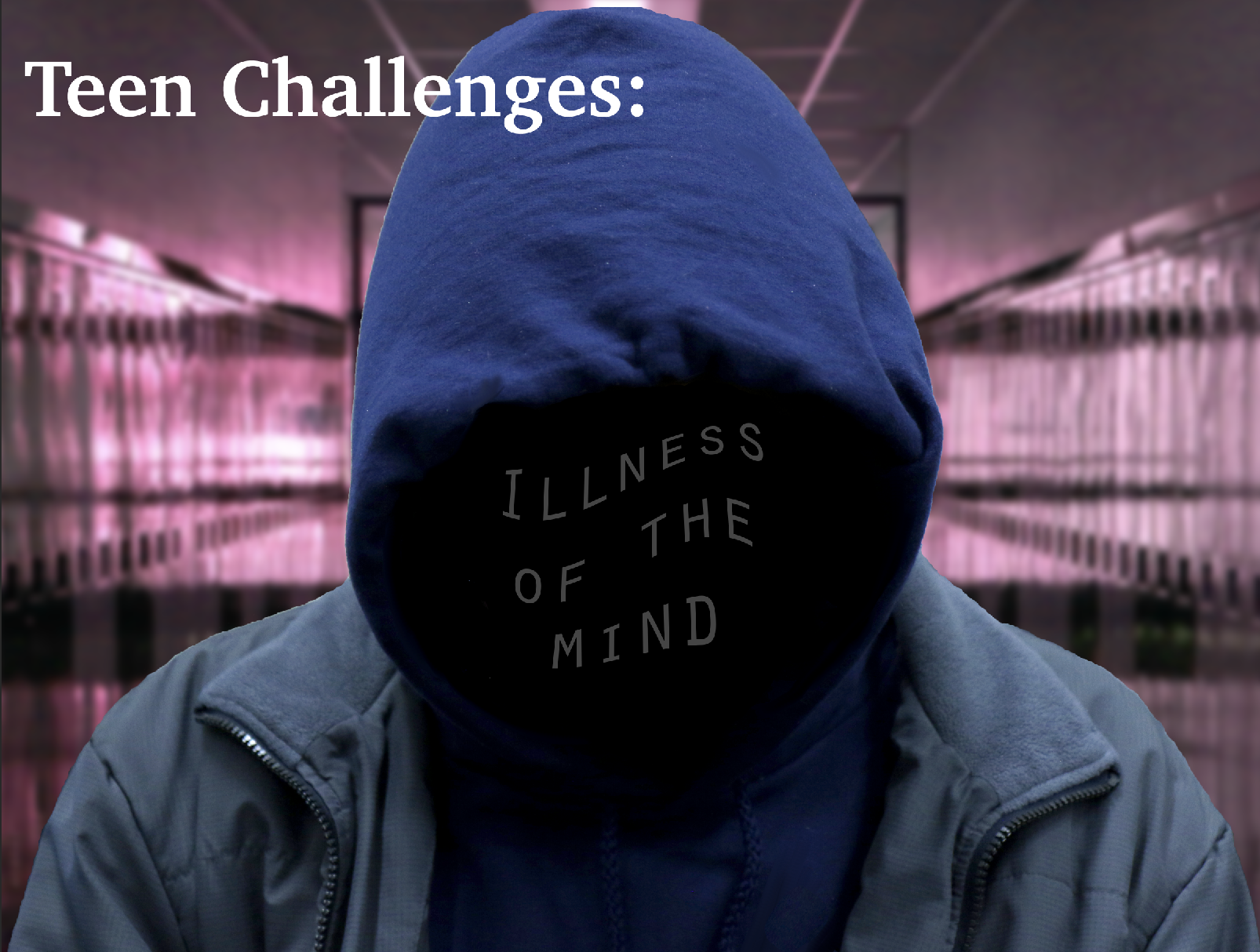Editor’s Note: All names of students have been changed in order to protect the identity of the students who shared their stories on the condition of anonymity
by Mayzie Talbot
She was sitting in math class, watching the teacher write on the board, when she suddenly felt like she was in danger. A voice in her head was screaming at her to get out, to run, to hide. So she did. Without any explanation she ran out of class and all the way to her car. She stayed there crying for half an hour until the panic attack was over, although it would take days for her to feel like herself again.
Amelia suffers from a panic disorder as well as anxiety and depression. She was diagnosed her freshman year after noticing that something wasn’t right in the way she was feeling.
Mental illnesses affects a large portion of students, with 20 percent of all youth ages
13-18 living with a mental disorder according to the National Alliance on Mental Illness (NAMI). A mental disorder is something that affects your mood, thinking and behaviors, such as anxiety, depression, schizophrenia and panic disorders.
In a lifetime, it’s estimated that 50 to 80 percent of individuals will experience some sort of mental illness, and the effects can be crippling.
Before Amelia received the proper help, she had thoughts of suicide and actually start- ed cutting herself.
“It’s a really sad thing when you feel so desperate that the only way that you can think to distract yourself from the pain going on inside is causing pain to your physical body,” Amelia said. “It didn’t hurt when I did it. When I was dragging the blade across my arms and my legs, it was like I couldn’t feel it. In the moment it was like it was just my brain focusing in on what I was doing.”
Days when Amelia has a panic at- tack can be terrifying for her.
“When it starts out it feels like I’m in danger; I feel like I have to run away,” Amelia said. “I don’t know what I’m running away from, but I feel like I have to get out of the situation immediately or something bad is going to happen to me. It’s a life or death situation. I can’t move, see, think. I feel like I’m going to die.”
She knows somewhere inside that she’s not in any danger, but the emotions and thoughts that come with a panic attack are too much for her to rationalize with herself very well.
“I know that it’s a panic attack, I know that it’s all in my head, but I can’t get myself to understand that,” Amelia said. “The first few times when it would happen, [my mom] would try to hug me and it would make me scream bloody murder because I knew it was my mom hugging me, but in my head, it wasn’t.”
A less common, but serious mental disorder is one that Felix has suffered from his whole life. Schizophrenia alters the way an individual interprets reality. Images and thoughts can become distorted which can seriously affect the way someone lives their day to day life.
“I’m constantly lonely, but I’m never alone,” Felix said. “I’m not alone in my own head. I don’t have control over my own thoughts, someone else does and for some reason he hates me. And he says things that I don’t want to hear and he shows me things that I don’t want to see. It’s hard to function in larger groups of people because I can’t handle all of the voices at once.”
When Felix was young, he thought his schizophrenia was something similar to the monster under the bed, but as he has gotten older, it has started to take over his life more and more as it gets harder to tell the difference between reality and the images in his head.
“I thought I had a friendship, like a proper friendship that I’ve had for years and then I found out I think three years ago that person never existed,” Felix said. “Someone I thought I had an actual relationship [with] someone I spent a lot of time with as a kid, wasn’t ever actually there.”
When someone doesn’t receive the proper help or doesn’t take the advice from their physician, the results can be dangerous.
Alice suffers from anxiety and was prescribed medication for it. However, it made her loopy and sleepy. It would ruin her appetite for days, so she stopped taking it. Instead she did breathing exercises, but that only got her so far. She wanted a complete distraction from her anxiety, so she turned to sex and alcohol.
“I just wanted to feel something, and if I couldn’t get that emotionally, well I was like, well you know physically I’m curious, and it will take my mind off[the anxiety],” Alice said.
But she soon found out that those things only served to make things worse. She hated herself for the things she had done, and she knew from herfirst hangover that the alcohol wasn’t helping anymore.
“I remember trying to laugh and then my heart would like constrict or something, like it would tighten auto- matically and I was like, ‘Well, s— I’m going to die, I’m just going to die like this is it,’” Alice said.
Nate Strait, the clinical director of the Central Utah Counseling Center, said most of his substance abuse clients are self-medicating. They take the alco- hol or the drugs to make them feel better, but it’s really not making them feel better.
“There is a rebound effect,” Strait said. “Initially they might feel better, but because of the effects of the drugs, when they come off of the substance, they actually end up feeling worse.”
What they’re doing is distancing themselves from those awful feelings, but it’s better to get medication pre- scribed by a physician. Physicians will prescribe medicine specifically targeted to help them with what they’re experi- encing.
Strait compares mental illness to having a broken leg and needing the right medical attention to aide in the healing process.
“Medications can help to kind of jumpstart the brain,” Strait said. “Much like someone that breaks a leg—their leg’s not going to work right until the
bone gets reset and heals. That’s what medication begins to do is to be able to kind of reset the brain.”
But medication isn’t the only way to help someone with a mental illness.There are many ways we can help as teachers, peers, parents and friends.
In recent years, technology has played a larger role in mental illnesses such as anxiety and depression. There is a trend in more use and a bigger risk for a men- tal illness.
Through electronic devices we can have a sense of social interaction but we typically avoid the physical contact side of it, which is a problem.
“Physical contact is vital to release a neurotransmitter known as oxytocin,” Strait said. “It’s vital in making us feel good.”
When we avoid physical contact, depression and anxiety are able to run more rampantly because we aren’t get- ting the physical contact that we need to release the oxytocin in our bodies.
This is where parents can step in and help their child to limit screen times and help to steer their child away from the dangers of the electronic world.
When it comes to the way mental health is viewed by the world, there are some serious misconceptions.
With Felix’s schizophrenia, he of- ten sees misrepresentation of the disor- der in popular TV shows such as “Law and Order” or “Criminal Minds.”
“They take schizophrenia and they make it some bad thing, like all schizo- phrenics are crazy, all schizophrenics are murderers, but it’s not really like that,” Felix said.
There are a lot of people who need help but refuse to get it because of the stigma surrounding those with a mental illness.
“They avoid coming in because they’re afraid of being labelled as one of those individuals and so they just stay away from being able to receive help,” Strait said.
Strait often has clients that want to park in the back of his office be- cause they are embarrassed to be seen there. They don’t want people knowing they’re going in and that they have a mental illness.
How To Help
One of the distinguishing features of depression that leans towards sui- cidal ideations is that feel worthless and
that they feel like they are a burden on others. They feel like they are not worth being here, they cause more problems than they’re worth.
If you have a friend who might be feeling that way or thinking that way you can help them by simply tell- ing them that you love them, that you care about them, you want them with you and basically show them you value them and their existence.
These affirmations can make a tre- mendous difference in someone’s life who may be struggling, according to Strait. To be able to see that they have made a difference in someone’s life, that they aren’t worthless.
“Simply just having a friend that’s there willing to lift them and put your arms around them is tremendous in helping others to be able to overcome challenges that are so prevalent in schools today,” Strait said.
One of the first steps in helping those plagued with a mental illness is to help them learn to combat the chal- lenges and truthfulness of negative thoughts and perceptions about them- selves. Strait tells his clients to think, “If I were to interview 100 people, would 100 people think I’m worthless?” This helps them realize their value and helps to build confidence within themselves.
Even though people that have a mental illness will likely face some dif-ficult times, they can still lead normal, healthy lives.
“I can still be a happy teenager even though I have depression,” Amelia said. “I can still be a confident young woman even though I have anxiety. I can still be in control and calm even though I have my panic disorder.”
EDITOR’S NOTE: As a general rule, the NS Times does not use anonymous sources except in special cases that include the following con- siderations: the information comesfrom a reliable source with direct knowledge of a topic, the source has important information that is es- sential to the story and that cannot be obtained any other way, and/or the information being shared would be damaging to the source. We are grateful for the students who were willing to share their difficult stories.




